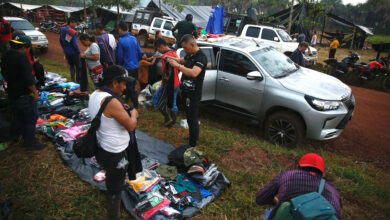Argentines take their frustrations, political demands to the streets

By Veronica Dalto
Buenos Aires, Jul 26 (EFE).- Demonstrations are gaining steam in the streets of several Argentine cities with protesters motivated by the desire to make their economic and political demands heard.
During the first half of this year, street protests increased by 60 percent over last year, during which harsh coronavirus quarantine was in place, but the numbers were only slightly below the figure for 2019, before the pandemic but the country’s economic crisis was worsening.
“People, above all, need to eat and the money doesn’t go very far,” Patricio Giusto, the executive director of the Diagnostico Politico (DP) consulting firm, told EFE.
“Going out into the streets is all the same, no matter the restrictions and the risk of infection, because the situation can’t go on like this any more,” he added.
According to DP, during the first six months of 2021 there were 2,474 social protests in Argentina, compared with 1,541 during the same period last year, both spans falling within the administration of Peronist President Alberto Fernandez, who took office in December 2019.
In all, during the first six months of 2019, under the 2015-2019 administration of conservative President Mauricio Macri, there were 2,493 demonstrations during which protesters blocked public thoroughfares or roads.
“There’s a record amount of picketing this year and since 2019 right here there’s also been a very significant number of opposition demonstrations,” analyst Sergio Berensztein told EFE on July 9, when opposition leaders convened a march by agricultural producers against government measures.
“There are many expressions of rebellion, of opposition, of dissatisfaction,” he said.
These demonstrations can particularly be seen from the door of the Social Development Ministry in the capital, where protesters are demanding an increase in state aid. Other key foci for demonstrations have been the Obelisk and the Casa Rosada presidential mansion.
Also quite common have been blockades of rail lines and access roads into the capital from the suburbs.
It is possible that the protests may be getting staged simultaneously.
Demonstrations are occurring in all of Argentina’s provinces, and the last spikes in protests were in Buenos Aires, Santa Fe, Neuquen, Chubut, Misiones and Santa Cruz, according to the DP, which added that they were mainly motivated by as yet unresolved union and social conflicts.
Argentina finished 2020 with 42 percent of its population classified as “poor,” and the first quarter of this year saw an unemployment rate of 10.2 percent, according to the National Institute of Statistics and Census.
However, there has not been a generalized social explosion – yet anyway.
Giusto noted that the demonstrations by social groups and the unemployed over the past two months are heading the list of protests. And self-organizing groups, in many cases, are protesting over social issues, to which may be added the problems of lack of safety and power outages.
“The content and the tone of the demands basically is linked to economics and social issues,” said Giusto, noting that inflation in June was 50.2 percent year-on-year within the framework of a recession that has lasted three years and after in 2020 the economy contracted by 9.9 percent.
“It’s probably the most critical economic situation in Argentine history,” he said.
Over the past two months, Giusto added, “the electoral component” has entered into the protests, given that in September the primary elections will be held in the run-up to the November legislative balloting.
He said that the demonstrations are being organized to call for more subsidies and other demands because “the electoral climate is such that many of these social organizations are going out with more strength to force the authorities” to take action and to demonstration the power of popular mobilization before the list of candidates is finalized.





